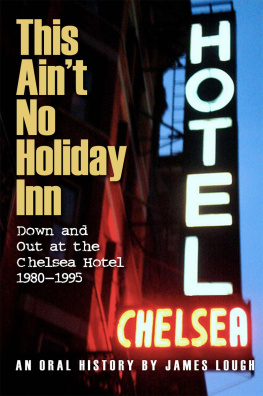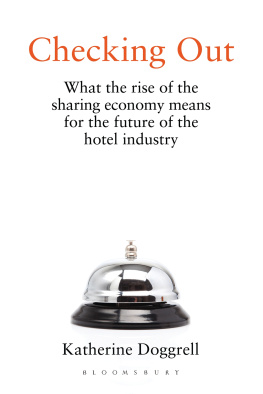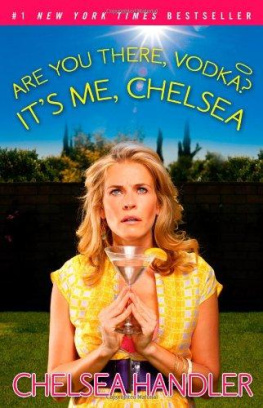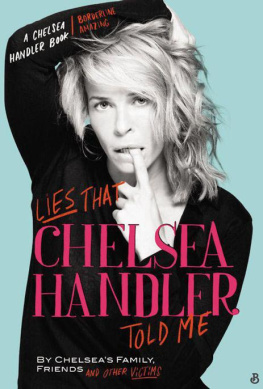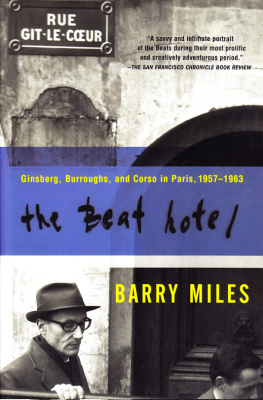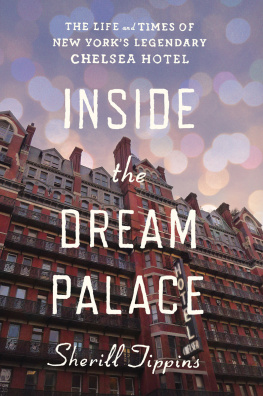Copyright 2013 James Lough and Robert Campbell
Published in the United States
All rights reserved. No part of this book may be used or produced in any manner without the written permission of the publisher.
For permission to reprint, contact:
Permissions: Schaffner Press, Inc. POB 41567, Tucson, Az 85717.
Library of Congress Cataloging-in-Publication Data
Lough, James.
This aint no Holiday Inn : down and out at the Chelsea Hotel, 1980-1995 : an oral history / by James Lough.
pages cm
Includes bibliographical references and index.
ISBN 978-1-936182-52-7 (trade pbk.: alk. paper) -- ISBN 978-1-93618253-4 (epub) -- ISBN 978-1-936182-54-1 (kindle) -- ISBN 978-1-93618255-8 (adobe)
1. Chelsea Hotel. 2. Hotels--New York (State)--New York. 3. New York (N.Y.)--Social life and customs--20th century. I. Title. II. Title: Down and out at the Chelsea Hotel, 1980-1995.
TX941.C44L68 2013
910.4609747--dc23
2013014869
I dedicate this book to my wife, Jennefer Morris-Lough, for cheerfully putting up with my extended periods holed up working in my office.
Authors Note
This book is an independent work of cultural history and commentary. HOLIDAY INN is a registered trademark of Six Continents Hotels, Inc. and is used in the title of this book pursuant to the Fair Use Doctrine. No affiliation with, and no sponsorship or endorsement by, any copyright or trademark owner, any business (including the current owners of the Chelsea Hotel) and/or any individual quoted or described in this book is claimed or implied by the author or the publisher.

Table of Contents
Chapter 1 :
CHECKING IN
Chapter 2 :
CHELSEA WILDNESS
Chapter 3 :
THE THREE WISE MEN OF DOPE:
Beat Writers Huncke, Corso, and Matz
Chapter 4 :
THREE CHORDS AND A GRUDGE:
Dee Dee Ramone and the Chelsea Hotel Blues
Chapter 5 :
GETTING BY
Chapter 6 :
STANLEY BARD:
Steel Fist in Velvet Glove
Chapter 7 :
CHELSEA PORTRAITS
Chapter 8 :
CHECKING OUT
Chapter 9 :
21ST CENTURY AFTERMATH
Epilogue :
FAUXHEMIA:
Does the Death of Bohemia Matter?


An early advertising postcard highlighting the buildings safety (above) and a brochure emphasizing the hotels proximity to the Chelsea Piers (below).


Introduction
At the Chelsea, we used to have this joke. When people were really acting outlandishly and out of bounds, we would shrug our shoulders and say: Well, this aint no Holiday Inn!
PAUL VOLMER
I finally made it to the Chelsea. For years I had phoned, emailed and snail mailed a small army of free-spirited Bohemians who had lived, loved, partied, created and crashed at the Chelsea Hotel from the 1980s through the 1990s (Crashed as in slept on somebodys floor, and crashed as in crashed and burned). I tracked down these eccentrics, interviewed them on the phone for hours and hoursmy dime. I bought them meals and drinks, urged and cajoled them to be part of this book. I even lent them money. For years, I read every book about the Chelsea Hotel, every magazine article, brochure and blog I could get my hands on. I watched all the movies shot in its venerable rooms and halls.
Now, finally, it was time to get at these eminent Bohemians in person.
I arrived on a dismal New York night in the pouring rain, a hangover from Tropical Storm Ernesto that had swept through the city the day before. The air was warm, sodden and dreary, the heavy drizzle would rally into a fierce downpour and withdraw back to a sulking haze. But weather be damned, I was thrilled to be there. The rain only made Manhattan glimmer all the brighter. The streets shone with red and green streaks, and even if it rained the entire week, wet or dry, it was all New York to me. Let it rain. Who cared? I was at the Chelsea, damnit!
When the cab pulled up to the curb, to my acute disappointment, the entire Hotel Chelsea was shrouded in steel scaffolding. Its brick surface was being tuck-pointed, repaired and improved, like the rest of the neighborhood.
The tuck-pointing would also prove symbolic of something the Bohemians had led me to expect, something they had warned me about time and time again: The Chelsea has changed. Its not like it was. It had been gentrified, they said, domesticated, tamed like the whole neighborhood, which, since the mid-90s, had turned distinctly upscale. The greasy diners were gone, replaced by uniform Starbucks. The boarded-up storefronts were now upscale spas. The neighborhood dives were now exclusive nightclubs replete with guest lists and doormen who turned the wrong people away. Everyone was saying the hotel, the neighborhood, all of Manhattan, had sold out.
I sincerely hoped that the death of the Chelsea, like the death of its former tenant Mark Twain, had been greatly exaggerated. I would dispel this myth and find some vestige of the places edgy, original energy.
And now I found myself standing amidst my luggage beneath the famous red and white candy-striped awning. I looked inside, waiting before taking the plunge, not out of any sense of wonderment, but to avoid spoiling the photo being shot by a well-heeled young tourist in a mustard-colored sport jacket and spiked hair.
Why all the excitement about arriving at a hotel? Because the Chelsea Hotel is not your ordinary hotelits a culture factory on hyper drive. Artists living at the Chelsea have probably produced more great paintings, sculptures, literature, theater, music, photography, and film than any American artistic movement. With an impressive record like this, its no surprise that myriad myths and half-truths about the Chelsea and its artists have ascended like a flock of blackbirds.
For example, its not exactly true that Dylan Thomas died at the Chelsea Hotel. He merely slipped into a coma there in Room 215 where he resided. He did the actual dying at St. Vincents Hospital in Greenwich Village. But after his bender at the White Horse Tavern, he did utter his alleged last words at the Chelsea: Ive had eighteen straight whiskeys, and I think thats the record.
Its debatable that punk rock icon Sid Vicious killed his girlfriend Nancy Spungen at the Chelsea. True, Spungen was stabbed to death in Room 102, and in the famous photograph, that is her body in the bag the paramedics are hauling out under the hotels red and white awning.
But, according to insiders at the Chelsea, people whod lived there forever, it was the small-time punk rocker and heroin dealer Rockets Redglare who murdered Nancy during an argument over money she owed him for drugs. During the fracas, Sid lay innocently sleeping in a heroin stupor.
It is true that Arthur Miller lived at the Chelsea, and Mark Twain. Janis Joplin did in fact service Leonard Cohen there on an unmade bed. Its true that the acting legend Sarah Bernhardt, in her penthouse apartment at the Chelsea, slept nights in her custom-made coffin beneath her custom-made pyramid. On the tenth floor, Stanley Kubrick did argue with Arthur C. Clarke over the screenplay for
Next page
